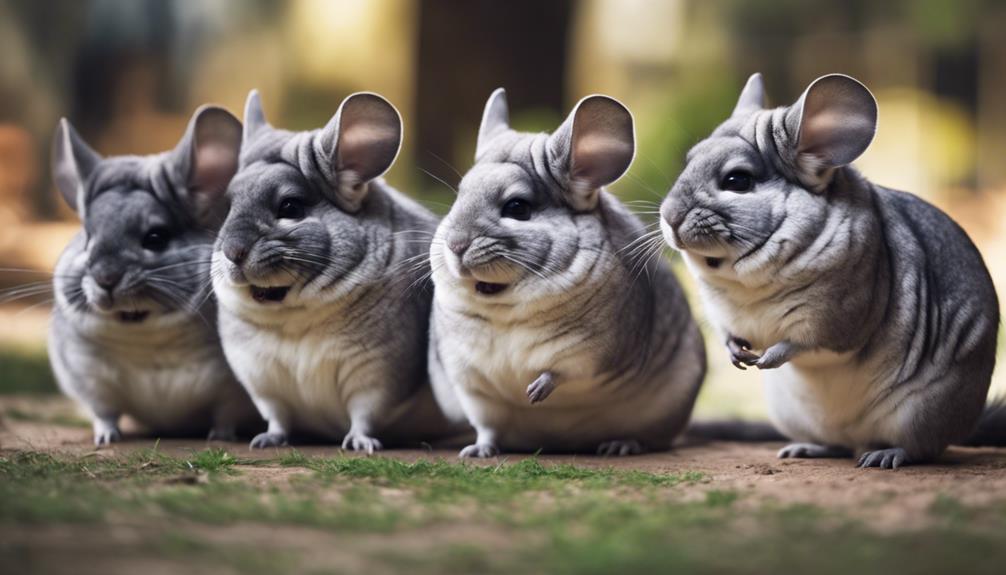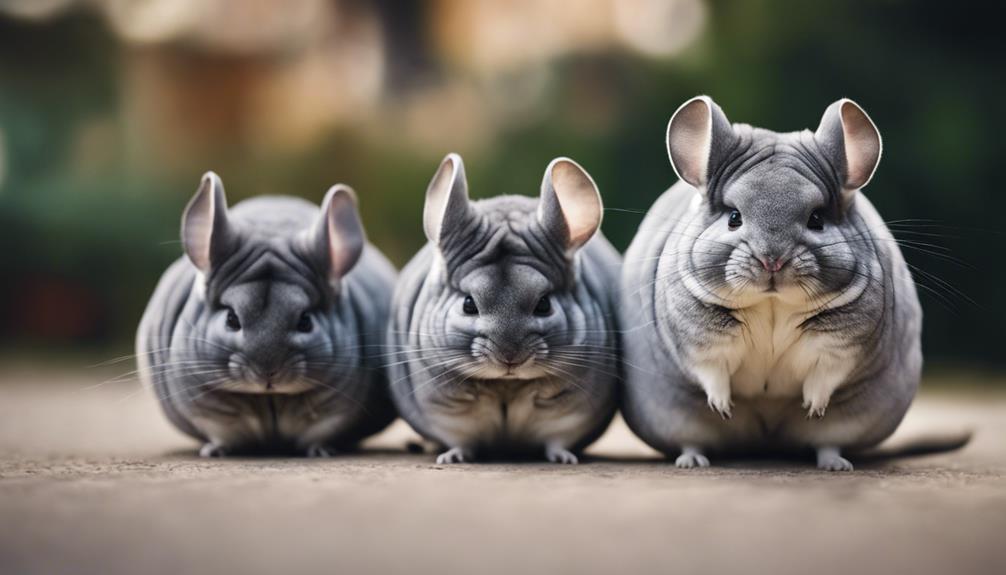What Are the Signs of Dominance and Submission in Chinchilla Groups?
In chinchilla groups, signs of dominance and submission can be observed through various behaviors. Dominant chinchillas typically exhibit assertive behaviors such as chasing, mounting, and vocalizing to establish their position within the group. They may also display territorial behaviors by marking their surroundings with scent glands.
On the other hand, submissive chinchillas will often display behaviors such as fleeing, crouching, or avoiding direct eye contact with dominant group members. They may also groom dominant individuals as a way to show respect and submission.
Understanding these signs of dominance and submission is important for chinchilla owners to ensure a harmonious group dynamic and prevent any potential conflicts within the group. By observing these behaviors, owners can intervene if necessary to maintain a peaceful coexistence among their chinchillas.
Body Language Cues

Chinchillas exhibit various body language cues to communicate dominance and submission within their groups. Dominance postures, such as standing tall with ears erect and fur puffed out, are commonly displayed by chinchillas asserting their authority. They may also engage in behaviors like chin rubbing or mounting other group members to establish dominance.
On the other hand, submissive signals are crucial for maintaining peace within the chinchilla hierarchy. These signals can include lying flat on the ground, avoiding direct eye contact, or grooming other group members. Group dynamics among chinchillas are intricate, with hierarchy cues constantly being exchanged through body language.
Understanding these cues is essential for caretakers to ensure a harmonious environment among chinchillas. By observing and interpreting the body language of these animals, individuals can better support the social structure within chinchilla groups, promoting a balanced and content community.
Vocalizations and Communication

Chinchillas in groups communicate through various vocalizations, with chirping often indicating dominance within the hierarchy.
Scent marking plays a crucial role in establishing and maintaining the social structure, reflecting the chinchillas' intricate communication system.
Additionally, subtle body language cues further solidify the dynamics of dominance and submission among these small mammals.
Chirping for Dominance
Chirping is a vocalization displayed by chinchillas to assert dominance within their social groups. In the chinchilla hierarchy, chirping serves as a key element of dominance displays. The dominant chinchilla often uses chirping to establish authority and control over others in the group. This vocal dominance is a clear indicator of their position within the social structure.
Conversely, chinchillas lower in the hierarchy may exhibit submission signals in response to chirping, indicating their recognition of the dominant individual's status. Understanding the role of chirping in chinchilla groups provides valuable insights into their social interactions and helps decipher the complex dynamics of dominance and submission within these adorable creatures' communities.
Scent Marking Hierarchy
Within chinchilla groups, scent marking serves as a crucial aspect of their hierarchical communication system, facilitating interactions and signaling social status among individuals.
- Scent marking dynamics: Chinchillas use scent marking to establish territorial boundaries and convey information about their identity.
- Social hierarchy: Dominant chinchillas often engage in more frequent and intense scent marking to assert their status within the group.
- Dominance signals: Higher-ranking individuals may strategically place their scent in prominent locations to assert dominance over others.
- Group dynamics: Submissive chinchillas may exhibit reduced scent marking behavior or avoid marked areas to minimize conflict with dominant group members.
Body Language Cues
In chinchilla groups, subtle shifts in body language cues, including vocalizations and communication patterns, play a significant role in shaping social dynamics and hierarchies. Group dynamics are often influenced by nonverbal communication, with chinchillas displaying various behaviors to establish leadership roles and social cues within their community.
Vocalizations, such as chirps, barks, and purring sounds, serve as important tools for chinchillas to express their emotions and intentions to other group members. Additionally, through grooming, scent marking, and body postures, chinchillas convey messages about their status and relationships within the group.
Understanding these body language cues is crucial for interpreting the intricate social interactions and hierarchies that exist within chinchilla communities, highlighting the importance of nonverbal communication in their daily lives.
Aggression and Conflict Resolution

Aggressive encounters among chinchilla groups often serve as a means for establishing dominance hierarchies and resolving conflicts within the social structure. In observing these interactions, several key behaviors can be noted:
- Dominance Displays: Chinchillas may engage in aggressive behaviors such as chasing, boxing, or vocalizations to assert their dominance over others in the group.
- Conflict Resolution Techniques: After a confrontation, chinchillas may engage in reconciliation behaviors such as grooming each other or engaging in play to restore harmony within the group.
- Submission Signals: Chinchillas may exhibit submissive behaviors like crouching, avoiding eye contact, or retreating to show deference to a more dominant group member.
- Resource Competition: Aggression often arises during feeding times or when resources are limited, with dominant chinchillas typically having priority access to food, water, or shelter.
Scent Marking and Territory

Chinchillas exhibit complex scent marking behavior to establish and defend their territories within a group. By marking their environment with unique scents, they communicate information about dominance status and boundaries, which helps reduce territorial disputes.
Understanding the intricacies of scent marking can provide insights into the social dynamics and hierarchy within chinchilla groups.
Scent Marking Behavior
Within chinchilla groups, scent marking behavior serves as a prominent communication tool to establish and maintain territorial boundaries. Chinchillas exhibit specific behaviors related to scent marking that are crucial for maintaining their social structure and hierarchy.
- Urinary Marking: Chinchillas release urine to mark their territory, conveying information about dominance and ownership.
- Scent Gland Marking: Chinchillas have scent glands on their cheeks, chin, and genital area, which they use to mark objects and each other.
- Rubbing Behavior: Chinchillas rub their scent glands on objects to transfer their scent, indicating their presence in the territory.
- Social Interaction: Scent marking is also a form of communication among chinchillas, helping them establish social hierarchies within the group.
Territorial Disputes
In chinchilla groups, territorial disputes often manifest through scent marking behaviors, reflecting the intricate dynamics of dominance and submission within the social structure. Dominance posturing can be observed as chinchillas vigorously rub their scent glands against objects to claim territory, while submission signals may include avoiding areas marked by dominant group members.
These behaviors play a crucial role in hierarchy establishment, where individuals assert their dominance through strategic scent marking. Territorial disputes can occasionally lead to conflicts among group members, but chinchillas have developed effective conflict resolution mechanisms.
Social Grooming and Bonding
Social grooming plays a significant role in fostering social bonds among chinchilla group members. Chinchillas engage in grooming behaviors that help strengthen their social connections and maintain harmony within the group.
- Mutual Grooming: Chinchillas engage in mutual grooming where individuals take turns grooming each other, reinforcing trust and camaraderie.
- Scent Exchange: During grooming, chinchillas exchange scents that help in recognizing group members and establishing familiarity.
- Hierarchy Reinforcement: Grooming rituals often reflect the social hierarchy within the group, with dominant chinchillas receiving grooming from subordinates.
- Conflict Resolution: Grooming sessions can also serve as a way to resolve conflicts within the group, as the act of grooming can help alleviate tension and promote reconciliation.
Through these grooming behaviors, chinchillas not only maintain their physical well-being but also contribute to the social fabric of the group, promoting cohesion and cooperation essential for their survival in the wild.
Food Sharing and Resource Access

Food sharing among chinchillas in a group setting reveals intricate dynamics of cooperation and competition within the community. Feeding behavior in chinchilla groups can be a combination of communal eating and individualistic foraging. Resource sharing is essential for group cohesion, but it also highlights dominant-subordinate relationships within the community.
| Dominant Chinchillas | Subordinate Chinchillas |
|---|---|
| Control food sources | Wait for leftovers |
| Eat first and most | Receive less desirable pieces |
| Display assertive body language | Show submissive postures |
| Guard food from others | Avoid confrontation |
Chinchillas often exhibit a pecking order when it comes to accessing food resources. Dominant individuals tend to monopolize choice food items and may even prevent subordinates from accessing them. In contrast, subordinate chinchillas show deference by waiting their turn or scavenging for scraps left behind by the dominant members. Understanding these feeding dynamics helps shed light on the intricate social structures within chinchilla groups.
Reproduction and Breeding Dynamics

Within chinchilla groups, mating behaviors and reproductive strategies showcase a complex interplay of dominance and submission dynamics. Chinchillas, like many social animals, exhibit fascinating behaviors when it comes to reproduction and breeding. Here are some key observations:
- Mating rituals: Chinchillas engage in intricate mating rituals that often involve displays of dominance and submission. These rituals can include vocalizations, chasing, and scent marking to establish hierarchy and breeding rights within the group.
- Social hierarchy: The social hierarchy within a chinchilla group plays a crucial role in breeding behavior. Dominant individuals may have greater access to mates and breeding opportunities, while subordinates may need to wait their turn or seek alternative strategies to reproduce.
- Breeding behavior: Chinchillas exhibit diverse breeding behaviors, ranging from monogamous pairs to more complex group dynamics. Dominant individuals may monopolize breeding opportunities, leading to competition and strategic alliances within the group.
- Group dynamics: Reproduction in chinchilla groups is influenced by the overall dynamics of the group, including size, composition, and individual relationships. Understanding these dynamics is essential to grasp the complex interplay of dominance and submission in breeding strategies.
Frequently Asked Questions
How Do Chinchillas Establish Their Hierarchy Within a Group?
Chinchillas establish hierarchy through dominance posturing and submission grooming. Group dynamics play a crucial role as they navigate social structures. Observing these behaviors provides insight into how chinchillas maintain order and relationships within their groups.
Do Chinchillas Display Different Dominance Behaviors Based on Gender?
Chinchillas typically exhibit distinct dominance displays influenced by gender roles. Males often assert dominance through physical posturing and vocalizations, while females may use more subtle submission cues and communication signals to navigate group dynamics.
Can Dominance and Submission Behaviors Change Over Time Within a Chinchilla Group?
Over time, dynamics can shift within chinchilla groups, reflecting the ebb and flow of group relationships. Interactions evolve, showcasing the fluidity of dominance and submission behaviors as chinchillas navigate their social hierarchy.
Are There Specific Behaviors That Indicate a Chinchilla's Submission to a Dominant Group Member?
In chinchilla groups, submissive behavior can be seen through lowered body language, avoidance, and quiet vocalizations. Dominant members may show aggression towards subordinates, while maintaining grooming relations with those in higher ranks.
How Do Chinchillas Respond to New Group Members in Terms of Dominance and Submission Dynamics?
In social interactions, chinchillas often exhibit behavioral changes when introduced to new group members. They may display dominance by asserting themselves or submission by yielding to established group dynamics. These adjustments help maintain harmony within the group.











